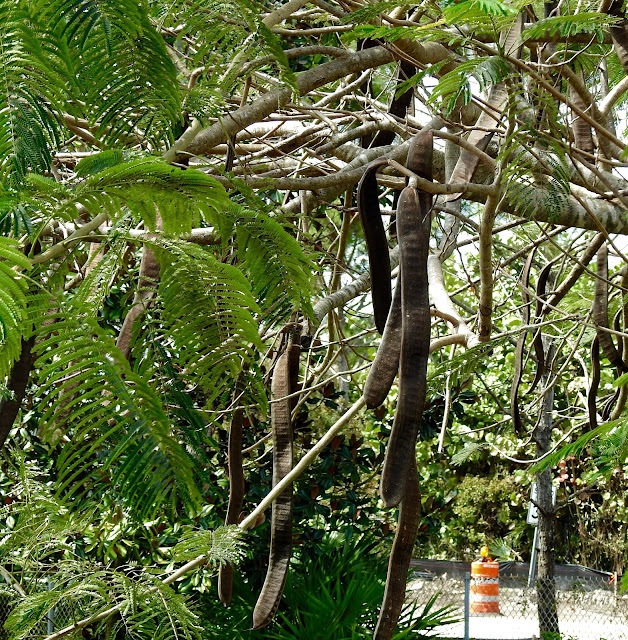 |
| One of the first flowers that fascinated me when I began to photograph plants in Florida. |
I've been collecting photographs of plants, trees, bushes and flowers for the last ten years. Brent gave me, first, a Sony camera with a simple zoom lens--after that, a Nikon D300s with (over the years) three different lenses. Then, last year, I got a Nikon P600 zoom camera--essentially a zoom lens that can take photographs of the craters of the moon.
My intention (only sporatically carried through) has been to document all of the plants in our yard. This is a fragment of my dream to compile an identification collection of photos and plant pressings of all the plants I find in our area.
One of the challenges in all of this is the seasonal changes--blooms come and go, even leaves on some plants dry up and fall off for a time each year. There are flowers that grow from underground root systems or bulbs--they send up sprouts, grow, wither and die.
 |
| This is one of the young Royal Poinciana trees along Donald Ross, just east of I-95. |
I have one entry for today, though: Royal Poinciana. It is a tree that spreads its branches over a huge circumference. Even though it grows as high as a telephone pole, the branches of an older, mature tree, brush against the ground when the wind blows. The Palm Beach State College, PGA campus, has some gorgeous trees. During the height of summer, standing under one of the trees' canopy, I am hidden from the sight of those walking on the sidewalks--just a half dozen yards away.
 |
| Here we see the height compared to a light pole: young Royal Poinciana tree, family Fabaceae, Caesalpinioideae, Delonix regia. |
 |
| From a great distance, the trees are easy to spot--blankets of flowers covering a wide dome. |
 |
| Seed pods hang down low after the flowers have gone. |
 |
| The blooms cluster at the ends of branches. A relative of the pea, the leaves are described as "fern-like." |
 |
| I took a close-up of a single flower, set at the base of a branch, to show the texture of the trees' bark. |
One of the best things about living in Florida is that it is green all year long.
In Iowa, I loved the fact that I could toss just about any seed on the ground and it would grow--especially "salad" plants: lettuce, tomatoes (those I started from small nursery stock), sweet peppers, carrots, radishes, spinach.
The same miracle happened in Kansas City, Missouri. There I was also able to get apple trees to survive--though we didn't live there long enough to see a harvest from them. We left a terraced flower garden built around a waterfall. An enclosed garden provided "salad" veggies as will as gooseberries, raspberries, and blackberries. We were known as the "sunflower house" because of the few giant sunflowers that sprouted in odd places around the house.
Now we live in Florida--Palm Beach. I've tried peach trees--died. Fig trees--no figs. Roses--mildewed. Tomatoes--burnt by the "partial sun." Lauren and her family are living with us for awhile and she has been able to get SURPRISE!!! WOW!!! BLACKBERRIES. I have a starfruit tree that bears delicious fruit twice a year--as does our Barbados cherry tree. My best success so far (aside from the wild roses I got from the Palm Beach State College nursery) has been a single mulberry bush that gives luscious, though few, berries every year. I have three pomegranate bushes that have done nothing except not die yet--and a sap apple that also has not died yet--and two coconut palms that I think have not decided if they are going to die yet or not.
I don't have a Royal Poinciana in my yard; I just get to be in a place that is constantly green and growing and filled with plants that I can take photographs of.
It is a place that I like very much.
No comments:
Post a Comment